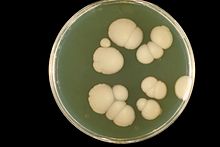Sabouraud Dextrose Agar


The Sabouraud dextrose agar ( Sabouraud Dextrose Agar or only Sabouraud agar , SAB) is a commonly used solid nutrient medium for growing molds , dermatophytes and yeasts (for example spp Candida. ) In microbiological samples. The culture medium is named after its inventor, the French bacteriologist Raymond Sabouraud .
Mode of action
In addition to up to 2% agar to solidify the medium and 1–2% peptone as nutrient, Sabouraud agar contains 4% glucose . The high content of glucose (= dextrose) promotes the growth of these microorganisms, while the simultaneous growth of bacteria is suppressed by an acidic pH value of 5.6. The Sabouraud agar is one of the so-called selective culture media. With further acidification or the addition of antibiotics such as cycloheximide , penicillin or streptomycin , the selective effect can be increased even further.
In addition to the Sabouraud agar with 4% glucose, there are other variants, such as the Sabouraud 2% glucose agar. This has the advantage of promoting the secondary metabolism of the mushrooms due to the lower glucose content, so that they tend to form pigments that facilitate identification. Furthermore, the Sabouraud 4% maltose agar; a Sabouraud agar, which contains 1% glucose and 1% maltose at the same time, as well as the bouillon variant without added agar (with 2% glucose) are used.
application
A change in the pH value to extreme values such as pH 3.5 or pH 10.0 serves to inhibit the accompanying bacterial flora. Mixing in acids or alkalis may only take place after sterilization in the autoclave . Antibiotic additives are also only added to the still liquid nutrient medium at around 50 ° C after sterilization. If not inoculated, the nutrient medium is clear and yellowish. The Sabouraud agar is usually incubated for two to five days, with some dermatophytes up to three weeks at 22 ° C. For some species , incubation at 35–37 ° C is recommended. Some molds and yeasts show identifiable colonies after just one day at 37 ° C.
Sabouraud 4% glucose agar and Sabouraud 4% Maltose Agar comply with the recommendations of the Pharmacopoeia of the United States ( United States Pharmacopeia ) and the European Pharmacopoeia ( Pharmacopoeia Europaea ). Sabouraud 2% glucose broth is used in antibiotic tests and corresponds to medium No. 13 according to Grove and Randall.
Typical composition
The nutrient medium usually consists of (data in grams per liter ):
- Peptone 10.0
- D - Glucose 40.0 (or other concentrations or other carbohydrates mentioned in the article)
- Agar-agar 15.0 to 17.0
See also
Culture media for the cultivation of yeasts and molds:
- Dichlorane-Glycerin-Agar
- Potato glucose agar
- Malt extract agar
- YGC agar
- YM (selective culture medium)
swell
literature
- Adolf Bauernfeind, Pramod M. Shah: Lexicon of microbiology and infectious diseases , 2nd edition. Schattauer, Stuttgart, New York 1995, ISBN 3-7945-1438-6 .
- FC Odds: Sabouraud ('s) agar. In: J. Med. Vet. Mycol. Vol. 29, No. 6, 1991, pp. 355-359, PMID 1815027 .
- RF Smith, D. Blasi, SL Dayton: Evaluation of media for selective isolation of yeasts from oral, rectal, and burn wound specimens. In: Appl. Microbiol. Vol. 28, No. 1, 1974, pp. 112-116, PMID 4602310 .
Individual evidence
- ↑ a b Sabouraud 2% Glucose Agar (Instructions for Use). (PDF; 152 KB) Carl Roth GmbH & Co. KG , April 2017, accessed on March 17, 2018 .
- ↑ a b c d Merck KGaA (Ed.): Merck Microbiology Manual 12th Edition . 12th edition. S. 418-424 .